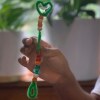These Yoga Poses and Mindfulness Games Can Help Kids Manage Their Emotions

One of the first tasks parents and caregivers take on is trying to interpret their children’s emotions. For babies, each cry signifies a different emotional message: hunger, pain, tiredness, fright, etc. and parents’ role is to adapt and troubleshoot those emotions. As children gradually get older, they’re taught how to identify, express and eventually regulate their own emotions. However, the development of emotional maturity is not always easy for children, especially as they encounter more complex life situations. For parents, staying calm when kids are feeling big emotions is challenging, and interpreting their emotional cues and troubleshooting them is an ever-changing learning process, and it’s normal for kids to experience a wide range of emotions.
Yoga can be a powerful tool to shift energy, regulate feelings and release emotions, as it connects our minds and bodies. The next time you recognize any of the following common emotional cues in your child, try these yoga and yoga-inspired movements with them to help them work through what they feel.
Pom-Pom Toe-Ga
Emotions: A case of the “sillies,” boredom or restlessness
Movement/Pose: Toe-ga (derived from the word yoga)
How To: Grab some pom-poms or cotton balls and scatter them across the floor. The goal is to try to pick up as many pom poms using only your toes and place them into cups. If standing and balancing on one leg to pick up the pom poms is too advanced, children can sit on the floor.
Benefits: While not quite a yoga pose, this game is fun, family-friendly, and great for a quick emotional reset. While children may think they are just playing, they are building self confidence and working on developmental skills such as balance, eye coordination, strategizing, as well as gross and fine motor movement.
Build On:
- Use this activity as a way to introduce balancing yoga poses such as warrior pose (see below).
- Practice color identification by calling out which color of pom pom to grab.
Warrior Pose

Emotions: Self-doubt or shyness
Movement/Pose: Warrior pose one and two
How To: There are several variations of warrior pose in yoga. For both, stand in a mountain pose with feet facing forward and arms at the sides.
For warrior one, keep the body facing forward, step back with your left leg and bend the right leg, making sure your knee doesn’t go past your toes, and raise your arms straight up. You can say “I am strong!”
For warrior two, keep the legs in the same position and rotate your upper body toward the left side. Then, stretch out your arms from your shoulders in opposite directions, with the right arm extending forward and the left arm extending backward while looking straight ahead. You can say “I am powerful!"
Repeat on the other side.
Benefits: All variations of warrior pose promote feelings of stability, strength and power.
Build On: Pair the warrior poses with “I am” affirmation statements — like I am strong, I am courageous, I am powerful — to encourage positive self-talk.
Legs on the Wall

Emotions: Tiredness or anxiety
Movement/Pose: Legs up the wall
How To: Sit down facing a wall as close to it as possible with your knees bent. Lower your back to the floor and extend your legs so they rest on the wall. You may need to make minor adjustments to move your bottom closer to the wall. Lay your arms wherever they feel comfortable and relax.
Benefits: The whole family can enjoy this restorative pose, which can help calm the mind and reduce anxiety. Putting your legs on a wall also increases blood circulation, which can feel great for young athletes with fatigued legs. When done for a few minutes, it can also help you relax your muscles and increase overall energy levels, which can help kids who feel tired but may not be able to or won’t nap.
Build On: Add eye pillows and blankets for added relaxation and support.
Freeze Dance Yoga
Emotions: Sadness, anger, restlessness, excitement or overstimulation
Movement/Pose: Freeze dance yoga
How To: Play some upbeat music. While the music is on, jump and dance. Then, pause the music and call out a yoga pose. Hold the pose for 10 seconds while trying to calm your body in the process. Repeat for the duration of the song.
Benefits: Music and dance are already powerful endorphin-releasing tools. Adding yoga to the mix makes this activity a trifecta for shifting our energy. The movement helps kids release energy, while pausing to do yoga poses allows them to focus and bring their attention inward. This mindfulness lesson also helps teach children that throughout the course of the day, it’s okay to pause and check in with or scan their emotions.
Build On:
- Instead of pausing to do yoga poses, use the pause to practice mindful breathing.
- Teach anatomy while exploring deep breathing. Have children place their hands on their stomach, heart, nose and in front of their mouths as they inhale and exhale. If you have bilingual kids, you can use this activity to remind them of the names of these body parts in their second language.
- For children 2-5 years old, try dancing along to “Yoga Clock (Tick Tock)” by Karma Kids Yoga for a guided freeze dance!
- Want to move in a different way? Make a spinner with words that describe what players can do, like "jump," "breathe," "stretch" or "shake."



